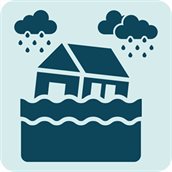Risk assessment for pluvial floods
To assess pluvial flood risk in the Netherlands, it is advisable to start with a basic assessment and gradually move to a more detailed assessment. The basic assessment provides a first indication of pluvial flood risk for a region. If there is susceptibility to pluvial flooding, a more detailed assessment can be taken to reduce uncertainties and gain a more specific risk insight.
Basic assessment
To understand an area’s susceptibility to pluvial flooding, the first step is to examine how precipitation characteristics change over time (PDF). Understanding variations in rainfall intensity and duration helps establish the potential for surface water accumulation. For this, you may consider combining historical observations of pluvial flood events with projections of future flood depths due to precipitation (see data access).
Next, it is advisable to identify locations where rainwater may accumulate and where the risk of groundwater flooding is higher. This includes examining land features that contribute to water pooling and assessing areas with drainage constraints. To do so, it is important to understand that differences in neighbourhood types – reflecting specific urban planning regulations – indicate a varying vulnerability to flooding. The Climate Impact Atlas map of neighbourhood typology qualitatively indicates each neighbourhood’s flood vulnerability based on its architecture and public space layout. Combining this information with water depth maps provides a picture of the more or less vulnerable areas.
In order to get an accurate picture at a local scale, a more detailed risk assessment is needed.
Detailed assessment
Determining the precise flood risk at a local scale—whether at street, plot, or building level—requires the use of accurate data. This is best achieved by following established methods for analysing the performance of sewerage and water systems. For climate stress testing, this approach has been enhanced with specific guidelines on input data and uniform assumptions, including the application of standard precipitation events.
In the assessment, it is advisable to incorporate multiple precipitation scenarios. A strong starting point is the dataset representing extreme downpours, such as 70 millimetres of rainfall over two hours (1:100 per year), ideally combined with data on prolonged rainfall. Beyond precipitation intensity, incorporating information on sewerage and drainage infrastructure is essential to ensure a comprehensive risk evaluation in the built-up environment. In the non-built-up environment, accounting for the initial saturation level of the system at the onset of an event is recommended to refine the analysis.
Simulating water depths
To simulate water depths effectively, it is recommended to follow the established approach outlined in the standards for the flood stress test (PDF) a background document used by researchers, modellers, and water managers. The methodology consists of the following steps:
- Define the purpose of the assessment – Establishing the goal of the analysis helps determine the required accuracy and detail of the simulation, sharping subsequent steps.
- Perform a qualitative system analysis – Define the boundaries and characteristics of the systems that will be simulated. Involving water management experts in this step is advisable.
- Set up the computation model – Apply a model schematisation approach in close collaboration with specialists from the municipality and water board. For the simulation of the built-up environment, the standard is to include the drainage and sewerage subsystems. For the non-built-up environment, the minimum requirement is to simulate the subsystems runoff over ground level and surface water.
- Test, calibrate and validate the model – Use historical data on pluvial flooding in the area and conduct a sensitivity analysis to ensure model reliability.
- Simulate water depths at standard precipitation events - Incorporate insights from the sensitivity analysis (step 4) to interpret the uncertainty margin of the results.
- Report limitations, uncertainties, and assumptions – Clearly document the factors influencing the accuracy and applicability of the results.
When performing the detailed assessment, it is recommended to keep sight of the following
- The threat of the occurrence of flooding is expressed in a spatial image of where rainwater accumulates, what the water depth is and preferably also what the expected duration of the water depth is.
- No specific tool (computational model) for simulation of water depths is prescribed. The recommendation is to use a model in which there is a link between processes at ground level, sewer operation and surface water system capacity.
- The stress test focuses on the (non-)built-up environments, and on bottlenecks that may arise from the interaction between the water systems of these areas.
- When interpreting the results, also use the results of other types of stress tests, including those of other regions, the main water system, and cross-border stress tests.
- Conducting the assessment offers insight into pluvial flood risk. However, it is important to recognise that the underlying model operates on certain assumptions. As a result, significant local variations at the individual object level may occur. More information on this can be found on the Assumptions & limitations page.

